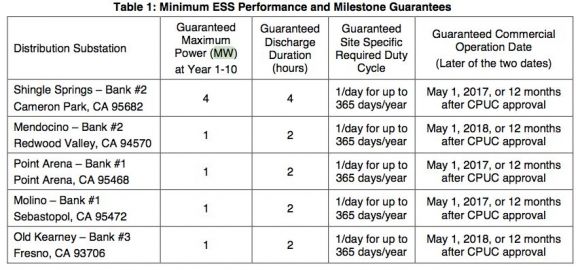California is the world’s biggest market for grid-scale energy storage -- as long as that storage can be delivered in targeted packages that can work at the grid's edge.
That’s one lesson to take from the request for offer (RFO) quietly issued by Pacific Gas & Electric last month, which is seeking up to 8 megawatts of energy storage to help back up remote distribution grid substations across its Northern California territory.
PG&E’s solicitation (PDF) is one of the first rounds from the 74 megawatts of storage projects the utility is set to announce by December. That, in turn, is part of the first procurement round for the state’s 1.3-gigawatt mandate for storage by 2021, which is requiring PG&E, Southern California Edison, and San Diego Gas & Electric to sign up about 200 megawatts of cost-effective grid storage by year’s end.
We’ve heard that at least 100 megawatts of storage projects are set to be announced this week in Southern California, where SCE and SDG&E are working on a long-term procurement plan to help cover the energy deficits left by closure of the San Onofre nuclear power plant. (UPDATE: SCE ended up procuring 250 megawatts of energy storage, including more than 100 megawatts of distributed, behind-the-meter battery storage -- a first for the indutry.
Some of these projects will be aggregating distributed, behind-the-meter batteries to help solve local grid needs. But PG&E’s substation RFO is aimed strictly at utility-owned and -operated battery systems -- which makes sense, because PG&E is justifying its cost by showing how much it saves by not building or upgrading new substations.

PG&E’s cost-benefit calculation for these projects is fairly straightforward -- subtract the cost of upgrading the substation from the cost of the battery system. Still, the duty cycle being asked of these energy storage systems (ESS) is pretty severe, according to the RFO:
“[T]his is defined as discharging the ESS from 100% state of charge (SOC) at guaranteed maximum power for the guaranteed discharge duration, then charging it to back to 100% SOC and subsequently discharging it at guaranteed maximum power for half of the guaranteed discharge duration, and finally charging it back to 100% SOC during the course of a single day. The ESS shall be capable of performing the guaranteed site specific duty cycle for up to 365 days per year excluding time for planned maintenance and/or forced outages.”
Four of the systems are being asked to provide 1 megawatt of power for at least two hours per day, while the largest, a 4-megawatt system, will have a four-hour running requirement. This timeframe matches up with the rules being set up by state grid operator CAISO for how storage can provide fast, multi-hour power-shifting for its resource adequacy (RA) programs, which is aimed at solving the “duck curve” problems caused by the growth of distributed rooftop solar across the state.
PG&E’s rules are also quite specific in terms of where the storage can be located, as this map of its Shingle Springs substation in the Sierra Nevada foothills demonstrates:

Asset or investment deferral of this kind is actually a significant route to market for existing battery-based grid storage systems, with projects around the world allowing stressed-out substations to keep operating for years longer by cushioning the peaks with stored battery power. In fact, PG&E has a 2-megawatt project in Vacaville that’s serving that purpose for a transmission substation.
But the new projects are some of the first targeting the medium- and low-voltage distribution grid, where the rules for batteries are different. California regulators are asking the state’s big utilities to come up with ways to value distributed energy assets -- solar panels, batteries, plug-in vehicles, smart thermostats and other grid-edge systems -- in their multi-billion-dollar, multi-year distribution grid investment plans.
PG&E didn’t disclose how much investment it’s hoping to defer with these new projects, or how much it planned to pay for them. But the numbers could be significant. In New York City, utility Consolidated Edison is proposing a plan to replace $1 billion in substation upgrades with a mix of energy efficiency, demand response, and distributed energy resources like rooftop solar and energy storage.



